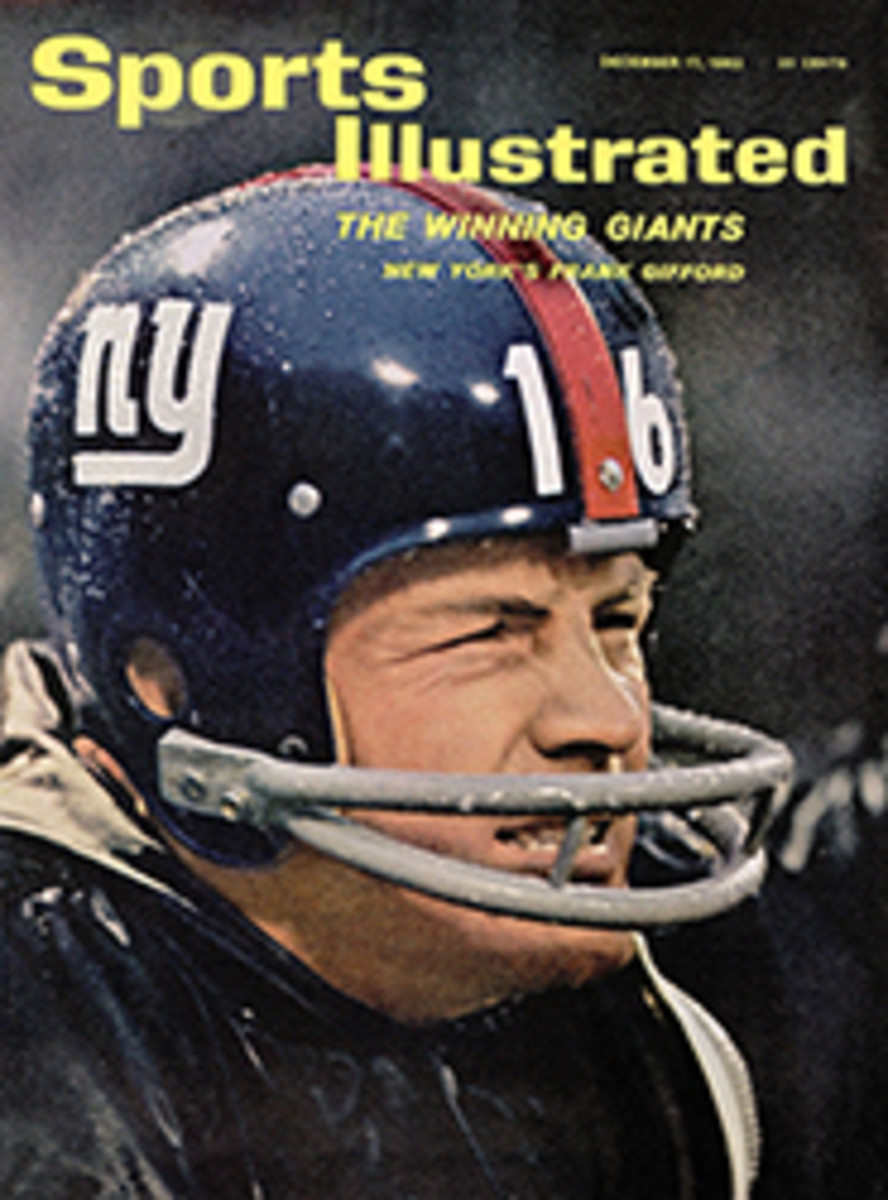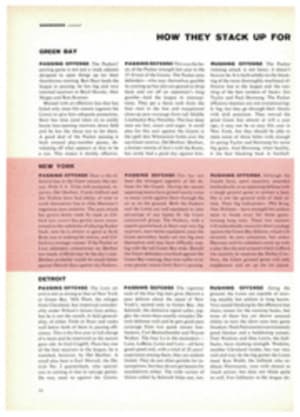
A squeeze-stretch program for an improved game
The most revolutionary advance in athletic training methods in recent years has been the increased use of isometric exercises that build up specific muscles by exerting them against an immovable object. One of the country's foremost authorities on the application of isometric principles to athletics is Jay A. Bender, head of the laboratory of applied physiology at Southern Illinois University (Oct. 30, 1961). Here he and Edward Shea, chairman of men's physical education at the university, present a unique combination of isometric and movement exercises designed especially to improve the condition of the muscles most used—and most likely to be strained—by golfers. It is not necessary to do all of these. Each corrects a specific weakness; the golfer can choose the ones he feels are the most important in his individual case.
FOR THE WRISTS AND FOREARMS
Rest both arms across the corner of a table. Cock the right wrist downward as far as possible. Place the left hand over the right palm, holding it firm. Then push up with the right hand for a count of six. Relax one second. Repeat twice more. Do the same exercise for the left wrist.
Bend the right wrist upward as far as possible. With the left hand gripping the right palm, push down with the right hand. Relax one second. Repeat twice, then reverse hands. In the first exercise tension must be felt on the thumb side of forearm; in the second, on the little finger side.
Hold an iron in the right hand. Grasp the right wrist with the left hand, immobilizing the forearm. Keeping the right elbow straight, slowly raise the club high behind the back, then slowly lower it to the floor. Repeat 10 times, then use the left wrist. The tension should be felt in the forearm and wrist, as indicated by the red area. Now hold the club in the right hand, using a standard golf grip (not shown). Grasp the wrist with the left hand. Slowly raise the club forward as high as possible, then lower it. Repeat 10 times and then do the same with the left hand.
FOR THE ARMS AND THE SHOULDERS
To strengthen the mid-shoulder area, that part of the body used as a stabilizer for the arms during the swing, sit on a stool placed flush against a wall, back touching the wall, feet planted firmly on the floor. Squeeze the shoulder blades firmly together. Then, with the arms straight, press the palms hard against the wall for a count of six. Relax for one second and repeat twice more. Now move the stool six inches from the wall. Contract the shoulder blades, press palms against the wall and repeat as before.
This mid-shoulder muscle exercise is designed to prevent the soreness that sometimes develops in that area after a game. Stand with the arms outstretched at shoulder height in front of the body, palms in. With shoulder blades drawn tightly together, slowly move the arms backward, keeping them parallel to the floor. After the arms have been brought back as far as possible, slowly return them to the original position. The shoulder blades remain contracted throughout. Repeat the exercise ten times.
This series of exercises will strengthen the left arm for the right-handed golfer and also make it easier to keep that arm straight during the backswing and downswing. Standing with the back tightly against a wall, raise the left arm up across the body past shoulder height, as shown in the drawing at left. The elbow is straight, the palm faces backward, the fingers are extended. The left wrist is grasped by the right hand, thumb up. The left arm is now pressed downward as hard as possible, with the left elbow remaining straight, while the right arm furnishes firm resistance. Tension should be felt in the under part of the upper left arm and in the little finger side of the left forearm. Hold the position for six seconds. After one second of relaxation, repeat twice more. Now strong tension should be felt in the area marked in red. The left arm is then dropped about eight inches and the same procedure is followed. The arm is dropped another eight inches, then a final eight inches. After completing this series, the left arm should be swung in an easy arc to relax the muscles.
FOR THE TRUNK AND THE LOWER BACK
This is a movement exercise to stretch and strengthen trunk muscles. Lie face down on the floor or on a table, knees and elbows kept straight. Slowly raise the right arm and left leg as high as possible, with both hips remaining flat. Hold the position for a count of two. Repeat the exercise 10 times, then raise the opposite limbs in the same fashion. If you have been under a physician's care for a back disorder, however, do not attempt these trunk exercises without his approval.
The isometric exercise at left is for the large and important muscles in the lower back and side. Lie face down, arms at sides, palms up, legs placed below a heavy bench, bed or sofa. Keeping the knee straight and both hips flat on the floor, raise one leg so that the ankle pushes hard against the unyielding resistance above. Hold the pressure for six seconds. Do this exercise three times, with one-second relaxation in between. Then follow the same procedure with the other leg.
To stretch lower back muscles, lie on a floor or table with the legs straight out. Tighten the abdomen muscles, bend the knees and draw them toward the chest. When they are close to the chest they are grasped by the hands and forcibly pulled toward the head for a count of six. Release for one second, repeat twice more.
The final trunk exercise is designed to increase suppleness. Stand with the feet 12 inches apart. Put a club behind the neck with the arms dangling loosely over it. While keeping the hips stationary and the back quite straight, turn the club in a relaxed manner to the right, then to the left, a total of 10 times in each direction.
TWO ISOMETRIC THIGH EXERCISES
This helps the muscles that take the strain of the shifting body weight during a swing. Sit on a table with a rolled-up towel under left knee, right leg placed over left at the ankle, both legs slightly bent and nearly parallel to floor. Press the left leg upward, hard. Relax for one second, repeat twice and then switch leg positions. Now do a similar exercise—not illustrated—while letting legs hang over the table edge with feet crossed at the ankles.
To strengthen inner thigh muscles sit on the floor, placing the weight on the hands with each ankle pressed against the outside of a chair. Keeping the legs straight, squeeze them toward one another as firmly as possible for a count of six. Then relax one second and repeat twice. Tension is felt on the inside of the thighs. Now, for the outer thigh muscles, place the ankles between the chair legs and exert pressure outward for the same count.
A CONDITIONING AND LEG EXERCISE
This is a very common exercise, but still one of the best for general conditioning of the body. It should be a part of the exercise program if leg weariness or overall fatigue trouble the golfer. Since it taxes the heart and lungs, it is recommended that those over 25 have a medical checkup before trying it, a proper precaution prior to undertaking any strenuous activity. The only equipment needed is a stool about 16 inches high and a watch. Stand in front of the stool. Step up with the left foot and then follow with the right. As soon as a standing position is reached on the stool, step off backward, left leg first, returning to the original position. The ascending and descending movements should take a total of about four seconds. The golfer in good condition can complete 15 steps per minute for a period of five minutes—each foot leading for two and a half minutes. If the lead-off foot falters before the exercise is half completed, it is all right to change the lead foot at frequent intervals. If you become tired during the exercise, stop. Progress should be recorded each day. When the goal of five minutes of 15 steps per minute is achieved, the pace can be speeded up to 20 steps a minute.
EIGHTEEN ILLUSTRATIONS
ROBERT T. HANDVILLE

